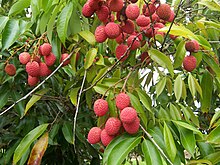Lychee
| Lychees | |
|---|---|
 |
|
| Scientific classification | |
| Kingdom: | Plantae |
| (unranked): | Angiosperms |
| (unranked): | Eudicots |
| (unranked): | Rosids |
| Order: | Sapindales |
| Family: | Sapindaceae |
| Subfamily: | Sapindoideae |
| Genus: |
Litchi Sonn. |
| Species: | L. chinensis |
| Binomial name | |
|
Litchi chinensis Sonn. |
|
| Lychee | |||||||||||||||||||||||||
| Chinese | 荔枝 | ||||||||||||||||||||||||
|---|---|---|---|---|---|---|---|---|---|---|---|---|---|---|---|---|---|---|---|---|---|---|---|---|---|
|
|||||||||||||||||||||||||
| Transcriptions | |
|---|---|
| Standard Mandarin | |
| Hanyu Pinyin | Lìzhī |
| Gwoyeu Romatzyh | Lihjy |
| Wade–Giles | Li4-chih1 |
| IPA | [lî.ʈʂɨ́] |
| Yue: Cantonese | |
| Yale Romanization | Laih-jī |
| Jyutping | Lai6-zi1 |
| Southern Min | |
| Hokkien POJ | Nāi-chi |
| Tâi-lô | Nāi-tsi |

|
|
| Nutritional value per 100 g (3.5 oz) | |
|---|---|
| Energy | 276 kJ (66 kcal) |
|
16.53 g
|
|
| Sugars | 15.23 g |
| Dietary fiber | 1.3 g |
|
0.44 g
|
|
|
0.83 g
|
|
| Vitamins | |
| Thiamine (B1) |
(1%)
0.011 mg |
| Riboflavin (B2) |
(5%)
0.065 mg |
| Niacin (B3) |
(4%)
0.603 mg |
| Vitamin B6 |
(8%)
0.1 mg |
| Folate (B9) |
(4%)
14 μg |
| Vitamin C |
(86%)
71.5 mg |
| Minerals | |
| Calcium |
(1%)
5 mg |
| Iron |
(1%)
0.13 mg |
| Magnesium |
(3%)
10 mg |
| Manganese |
(3%)
0.055 mg |
| Phosphorus |
(4%)
31 mg |
| Potassium |
(4%)
171 mg |
| Sodium |
(0%)
1 mg |
| Zinc |
(1%)
0.07 mg |
|
Link to USDA Database entry
Vitamin B6/Folate values were available |
|
|
|
| Percentages are roughly approximated using US recommendations for adults. Source: USDA Nutrient Database |
|
The lychee, litchi, liechee, liche, lizhi or li zhi, or lichee (Litchi chinensis; Chinese: 荔枝) is the sole member of the genus Litchi in the soapberry family, Sapindaceae.
It is a tropical fruit tree native to the Guangdong and Fujian provinces of China, and now cultivated in many parts of the world. The fresh fruit has a "delicate, whitish pulp" with a floral smell and a fragrant, sweet flavor. Since this perfume-like flavor is lost in the process of canning, the fruit is usually eaten fresh.
An evergreen tree reaching 10–28 metres (33–92 ft) tall, the lychee bears fleshy fruits that are up to 5 cm long and 4 cm wide (2.0 in × 1.6 in), weighing approximately 20g. The outside of the fruit is covered by a pink-red, roughly textured rind that is inedible but easily removed to expose a layer of sweet, translucent white flesh. Lychees are eaten in many different dessert dishes, and are especially popular in China, throughout Southeast Asia, along with South Asia and parts of Southern Africa.
China is the main producer of lychees, followed by India (Bihar accounts for 71% of annual production in India), with production occurring among other countries in Southeast Asia, the Indian subcontinent and South Africa.
Lychee has a history of cultivation in China going back to 1059 AD. Cultivation began in the area of southern China, Malaysia, and Vietnam. Wild trees still grow in parts of southern China and on Hainan Island. There are many stories of the fruit's use as a delicacy in the Chinese Imperial Court. It was first described and introduced to the West in 1656 by Michal Boym, a Polish Jesuit missionary (at that time Polish–Lithuanian Commonwealth).
...
Wikipedia
